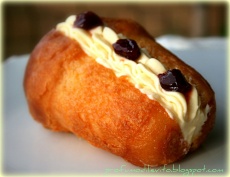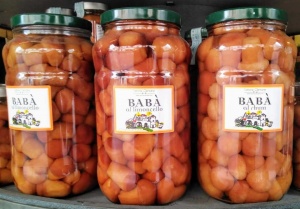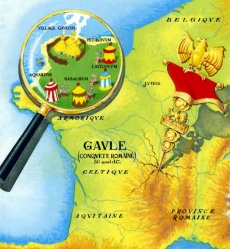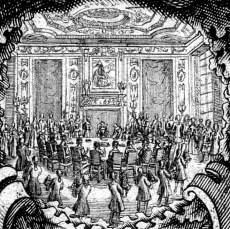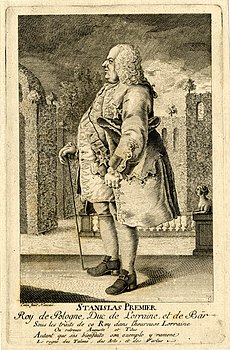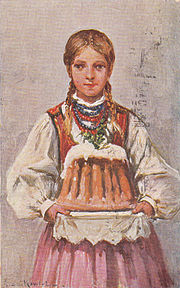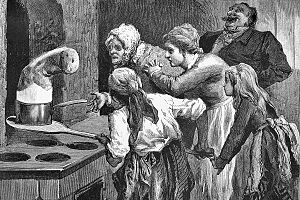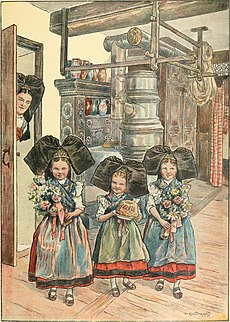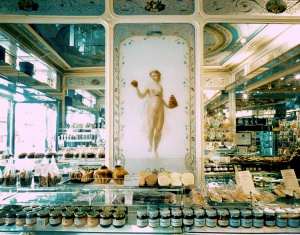Good King Stanislas and the Forty Thieves
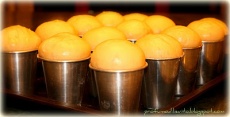
Easter is here, which is a good occasion to write something about the baba, a tall, rich yeast cake traditionally served in Poland for Easter breakfast. But before we move on to the Polish baba, let's take a look at the babà al rum, which the Neapolitans consider their unique regional speciality.
Si 'nu babà
Babà al rum is a kind of oversized cupcake that is baked, usually more than one at a time, in a can-shaped mould so that the dough over the edge to form a mushroom-like shape. Once it's done, removed from the mould and cooled down, the babà is soaked in runny syrup mixed with some rum (hence the al rum in the name) or limoncello (local lemon liqueur). Neapolitans like this delicacy so much that the word babà has become a synonym for anything or anyone that is particularly sweet and attractive. This is what Ms. Carla Nuti, an Italian psychologist, who describes human personalities by comparing them with desserts, has to say about the origin of the babà and its name:
| "Tu si nu babà!" [literally: "you are a baba!"] is a compliment Neapolitans use to tell their girlfriends that they are lovely, beautiful, attractive and sweet.
The babà, a truly Neapolitan speciality, is in fact of Polish origin. Stanislao Leszczinski [sic], King of Poland and a great gourmet, is said to have one day angrily pushed away a dessert he wasn't fond of and to have accidentally spilled some rum on it, which gave the dish a more inviting scent and look, thus winning the royal palate. The sovereign, inspired by Ali Baba, a character from One Thousand and One Nights, gave his name to this delicacy. The baba first arrived in Paris and then in Naples, together with the "monslù", or chefs employed by Parthenopean [that is, Neapolitan] noble families, where it acquired its characteristic mushroom shape. I like to bake this cake in a round mould with a hole in the middle and to decorate it with little babàs along with some pastry cream or whipped cream, even though "true" Neapolitans consider such additions sacrilegious. | ||||
— Carla Nuti: Una psicologa in cucina, Roma: Sovera Edizioni, 2011, p. 107, own translation
Original text:
|
Mr. Fabrizio Mangoni, who describes himselfs as "just like Stanislao, an urbanist and a gourmet", described the former Polish king's alleged invention of the babà, in even more colour:
| The golden, wavy, spongy surface had just detached from the mould. It looked like something between a turban and a pagoda, an architecture of new texture, built out of concentric cirles growing smaller and smaller towards the top. Stanislao soon understood that he had found an answer to his own desires. It looked soft and was supple to the touch. Its fine texture and the scent it spread made it an absolute novelty. Even before tasting it, he knew that he had invented a dessert like no other in his land or in his times; a rare point of equilibrium between consistency and lightness. A bit like his own life.
This is the beginning of the long journey of the babà, a mythical dessert invented in the mid-18th century by Stanislao Lekzinsky [sic], ex-King of Poland and Duke of Lorraine at the time. A journey which has many links with the Orient. Stanislao had spent much time in Ottoman captivity and had the opportunity to study and sketch the architecture of that land, which would later inspire the pavillions decorating his ducal palace, along with an enormous theatre of automata. At first, the babà was dry, filled with sultana and Corinthian raisins, and most importantly, it spread the scent of saffron. For its exoticism, the novelty of its taste and texture, Stanislao dubbed the dessert Ali Baba, in reference to One Thousand and One Nights, whose French translation he had read during his stay in the sultan's prison in Constantinople. | ||||
— Fabrizio Mangoni: I viaggi del Babà, in: Festival della letteratura di viaggio, Roma: Società Geografica Italiana Onlus, 2017, own translation
Original text:
|
How much of all that is true? Should Stanislao really get the credit for inventing the rum baba and does its name really come from a fairy-tale Arab craftsman who robbed the forty thieves of their sesame treasure? As you can see from the quotations above, the first stop on our journey to unravel this mystery is going to be in France.
Babaorum
According to one popular publication about the history of France, the rum baba dates back all the way to antiquity. The French term for this dessert, baba au rhum may have come from the name of a Roman military camp called Babaorum. In Julius Ceasar's time, it was one of the four Roman camps surrounding the last independent Gaulish village in Armorica. The other three were called Laudanum, Petibonum and Aquarium.[1]
Yet a different source, Larousse Gastronomique, the Bible of French cuisine, confirms the story of King Stanislas inviting the baba and naming it after a character from a Arabic fairy tale.
| Baba, a cake made from leavened dough that contains raisins and is steeped, after baking, in rum or kirsch [Alsatian cherry liqueur] syrup. […] The origin of this cake is attributed to the greediness of the Polish king Stanislas Leszcsynski [sic], who was exiled in Lorraine. He found the traditional kouglof [Alsatian bundt cake] too dry and improved it by adding rum. As a dedicated reader of the Thousand and One Nights, he is said to have named this creation after his favourite hero, Ali Baba. This recipe was a great success at the court of Nancy [capital of Lorraine], where it was usually served with a sauce of sweet Málaga wine. […] Stohrer, a pastrycook who attended the court of the Polish king, perfected the recipe using a brioche steeped in alcohol; he made it the speciality of his house in the Rue Montorgueil in Paris and called it 'baba'. |
| — Larousse Gastronomique, ed. Joël Robuchon, Hamlyn, 2009 |
As we shall see, Larousse Gastronomique isn't any more reliable than Astérix as a source of knowledge about history. After all, why should have Stanislas taken an Alsatian kouglof and steeped it in Alsatian kirsch while staying in Lorraine? Was this recipe really developed by the king himself or rather by one of his pastrycooks, such as the aforementioned Stohrer? And most importantly, why would a Pole name a cake after some Ali Baba, if in his own language the word baba had been already used for yeast cakes for centuries?
It looks like we need to take a closer look at this King Stanislas and his relation to the baba. You could shoot a few action movies based on his biography, but I will do my best to recap his life and his times as succinctly as possible.
A King-in-Exile
Poland entered the 18th-century as a great power in decline, in personal union with Electorate of Saxony, a small, but rich, state in what is now eastern Germany, under King Augustus II of House Wettin. Just before the end of the previous century (1698), Augustus was visisted by Tsar Peter the Great of Russia, on his way back from his grand survey of Europe. Both monarchs were unusually tall, strong and able to consume copious amount of alcohol. So when they met, they engaged in a several-day-long bout of binge drinking punctuated with cannon-shooting and bare-handed-horseshoe-breaking contests. And, while they were at it, they also decided to wage war against Sweden. A coalition of Saxon, Russian and Danish forces attacked the mighty Baltic empire soon afterwards (1700). But like many drunken ideas, so did this one go not exactly as intended. The Swedes smashed the Danes in Zealand, the Russians at Narva and the Saxons on the Daugava, and then proceeded to invade Poland. Polish senators tried to explain to King Charles XII of Sweden that Augustus was at war with him as elector of Saxony rather than as king of a neutral Poland – to no avail. The Swedes soon captured Vilno, Warsaw, Poznań and Cracow (1702), and Charles started looking around to find a new king for Poland. His first choice was James Sobieski, the eldest son of the previous king, but Augustus had him imprisoned in Saxony (1704).
The anti-Saxon opposition in Poland sent a delegation to the king of Sweden, headed by the Palatine of Poznań, Stanisław Leszczyński (pronounced stah-NEE-swahf lesh-CHIN-skee). King Charles was so charmed by the young, handsome, well-read and eloquent palatine, that he decided to make Stanisław his own puppet on the Polish throne. The royal election of 1705 – the first in Polish history to be conducted in the presence of foreign troops – was widely considered a farce, but it did dutifully elect the 28-year-old Leszczyński as the dethroned Saxon's successor. He was crowned (in Warsaw rather than in Cracow, the traditional coronation site) with a crown which Charles had lent him for the ceremony and took back just afterwards. The reign of Stanisław I lasted no longer than four years. The situation changed dramatically when the Russians crushed the Swedish army at Poltava (1709), forcing King Charles into exile in the Ottoman Empire. Augustus got his Polish throne back, while Stanisław ran to the Swedish city of Stettin (now Szczecin, Poland) and thence to the Ottoman Empire, to consult further plans with Charles.
Bender, a town in what is now Transnistria (between Moldova and Ukraine), was where King Charles stayed a for a few years after Poltava and the only place in the Ottoman Empire where Stanisław spent any amount of time. He never was in Contantinople, let alone in an Ottoman prison. Eventually (1714), Charles gave him the Swedish-owned Duchy of Two Bridges (now Zweibrücken, Germany), where the former Polish king, inspired by Ottoman architecture, built himself a little palace he called Tschifflik (from Turkish çiftlik, or "farm"). Unfortunately, Stanisław had to move out after his Swedish protector passed away (1718), so he moved to a modest palace in nearby Wissembourg. It's a town in Alsace, a border region which by that point had belonged to France for almost forty years, but was still mostly German-speaking (Alsace would later change hands between Germany and France like a ping pong ball, eventually staying with the latter). Maybe Stanisław would have stayed there for the rest of his life, if not for an unexpected visit by matchmakers from Versailles, who asked him for his daughter's hand in the name of King Louis XV of France. And so Princess Marie Leszczyńska married Louis, seven years her junior, and proved to be an ideal wife; she gave him ten children without getting much in the way of his liaisons with numerous mistresses. Her parents, who wanted to be closer to their daughter, moved in to Chambord, one of the most luxurious châteaux of the Loire Valley.
Meanwhile, back in Poland, Augustus II continued to reign until he ended his gluttonous life by dying from gangrene after diabetic foot amputation (1733). Stanisław, counting on his son-in-law's support, decided it was a good occasion to try and win back the Polish throne. He travelled incognito back to Warsaw, where he made his sudden appearance on the election field and was chosen – legally, this time – as king of Poland. His earlier coronation was deemed valid, so there was no need to repeat it. However, the history from almost thirty years before repeated itself in reverse – foreign troops, Russian this time around, captured Praga, the eastern suburb of Warsaw, where they arranged a rival election of Augustus II's son, soon afterwards crowned in Cracow as King Augustus III. Stanisław escaped from Warsaw to Danzig (Gdańsk), a city which managed to hold out against a Russian siege for some time. A network of alliances covering Europe transformed the fight for the Polish throne into a major international conflict, which – despite being known as the War of Polish Succession – was fought out mostly in Italy and on the banks of the Rhine. France was quick to capture Lorraine (another border region), but (except a small and unsuccessful landing operation in Westerplatte near Danzig) did little to help Stanisław keep his crown. In the end, Danzig fell and Stanisław, disguised as a peasant, escaped (once again) to Königsberg (now Kaliningrad, Russia).
The war ended with Augustus III staying on the Polish throne; as a consolation prize, Louis XV gave his dad-in-law the Duchy of Lorraine and Bar (1737), where Leszczyński lived out his years while still being addressed as "king" and where, in the words of Voltaire, he was "able to do more good than all the Sarmatian [that is, Polish] kings ever managed to do on the banks of the Vistula."[2] Lorrainers still remember Leszczyński as King Stanislas the Good (Stanislas le Bienfaisant), even though he earned this moniker due to the "good tsar, bad boyars" principle, finally living his dream of reigning as a charitable enlightened monarch surrounding himself with artists and philosophers, while leaving the day-to-day chores of running the government to his French chancellor, the widely hated Marquis de La Galaizière.
Although Stanislas and the Wettins were fierce political rivals, the were united in their love of good food, sweets, wine and women. In Poland, the reign of Augustus III finally brought a period of long-desired peace, now known as the "Saxon Carnival", when the Polish nobility lived out the proverb:
Under a Saxon king, | ||||
— Polish saying (18th century)
Original text:
|
Meanwhile, Stanislas, in his "little Versailles" at Lunéville, hosted Voltaire, Rousseau and Montesquieu, enjoyed the theatre of automata in his exotic gardens and stuffed his face with fantastic creations sculpted from sugar and ice cream by his court confectioner Joseph Gillers. He got terribly fat, but still outlived Augustus III; he chose not to fight for the Polish throne again, though, leaving Empress Catherine the Great of Russia to pick his namesake, Stanisław Poniatowski, as Poland's new (and last) king (1764).
One of the shortest-reigning kings of Poland, but also the longest-lived, died a particularly nasty death. It's said that he wanted to light his pipe or that he just plunged himself in deep thougth next to a fireplace; but pissing into the fireplace wasn't unusual at all back then, especially for elderly monarchs who didn't always feel like walking all the way to the outhouse. In any case, his clothes caught fire and the former king died from severe burns after a few days of agony.
TL;DR: Stanisław Leszczyński became king of Poland, then he was exiled, lived in Alsace for some time, then he became king of Poland and got exiled all again, and spent the rest of his life as duke of Lorraine and a great gourmet. But so far, we haven't learned anything new about the baba.
Baba, baby
The Polish word baba is unusually rich in meanings. In its original Proto-Slavic sense, it refers to a grandmother or, by extension, any elderly woman. In old Poland, the same word used for any peasant woman and is still used to describe a an uncouth, boorish woman. Other meanings include "female street vendor", "herbalist", "midwife" and "witch" (as in the most famous Slavic witch, Baba Yaga). A baba may even refer to a married or widowed woman of any age, as in moja baba, "my wife". You can use the diminutive form, babka, for a young and attractive woman, much like the babà in the Neapolitan dialect of Italian. But don't over do, because if you diminutize the word even further, you'll get babcia, or "granny".[3]
The plural and genitive form of baba is baby (pronounced BAH-bih, not BAY-bee). You can sometimes see in Poland some half-translated labels, like żel do mycia baby, which was probably meant to say "baby washing gel", but actually says "crone washing gel". When Eugeniusz Bodo sang "ach te baby" in the 1930s, he wasn't addressing his one and only baby; he meant all women in general. Or did he mean the cakes?
Lovely 'baby', oh these 'baby'! | ||||
— Jerzy Nel, Ach te baby (1933), own translation
Original text:
|
So which of this many meanings gave rise to baba, the cake? Did the cake use to resemble a stone idol, also called baba in Polish? Or does the cake's name come from its resemblance to a peasan't woman's pleaded skirt? Or perhaps, it's always been old women who were most experienced in the tricky art of yeast-cake baking?
After all, baking a beautifuil, tall, airy baba was one of the most demanding tasks Polish home cooks ever had to face. Great care was needed to prevent the cake from sinking or browning a little too much. A housewife who aimed for the perfect baba had to start by choosing the best ingredients – high quality wheat flour, good beer yeast and fresh butter. The oven had to be heated as much as possible, so that it could keep a constant temperature for a long time. The moulds had to be perfectly clean before being filled with dough and popped into the oven. Then came the almost magical practices whose goal was to prevent the baba from getting cold and falling. Doors and windows were sealed to avoid drafts, women walked on their toes and talked in whispers when close to the oven, and finally, the baba was gently placed on down pillows for cooling. And of course, no men were allowed in the kitchen; the baking of a baba was a baby-only affaire.[4]
W każdym razie słowo „baba” w znaczeniu „ciasto” pojawiło się w polszczyźnie już co najmniej XVII w.[5] Oto na przykład opis święconego na dworze książąt Sapiehów za panowania króla Władysława IV (pan. 1633–1648, długo zanim Leszczyński pojawił się na świecie), gdzie bab nie mogło zabraknąć:
In the middle stood a lamb with a pennon representing the Lamb of God, all in pistachios […] | ||||
— From an undated almanach, quoted in: Łukasz Gołębiowski: Lud polski, jego zwyczaje, zabobony, Warszawa: Drukarnia A. Gałęzowskiego i Spółki, 1830, p. 309–310
Original text:
|
Od Stohrera do Savarina
O ile samo słowo „baba” jest niewątpliwie pochodzenia słowiańskiego (więc nie było potrzeby zapożyczania go z języka arabskiego), to nie ma powodów sądzić, że drożdżowe ciasto wypiekane w formie o kształcie turbana jest rdzennie polskim, czy w ogóle słowiańskim wymysłem. Takie same ciasta, choć znane pod różnymi nazwami, od dawna wypieka się w całej środkowej Europie, od Holandii, poprzez Alzację, Niemcy, Szwajcarię, Austrię, Czechy, Polskę, aż po Rosję. W krainach niemieckojęzycznych nosiło ono nazwę „Gugelhupf” lub „Kugelhupf”. Że Kugelhupf nie musiał być zawsze na słodko, świadczy fakt, że na polskich Kresach Wchodnich do tej pory jada się babkę ziemniaczaną z cebulą i boczkiem (w wersji żydowskiej bez boczku), a mówi się na nią „kugel”, „kugiel”, bądź (po litewsku) „kugelis”.
Pochodzenie tej nazwy jest bardziej zagadkowe niż naszej „baby”. W dzisiejszej niemczyźnie „Kugel” to „kula”, ale ciasta przecież nigdy nie robiono w takim kształcie. Być może Gugel pochodzi z łacińskiego cucullus („kaptur”), a Hupf to odpowiednik polskiego „hop”; ale co ma podskakujący kaptur do baby drożdżowej? Według pary słynnych niemieckich etymologów, braci Jacoba i Wilhelma Grimmów (którzy przy okazji badań nad językiem spisywali baśnie ludowe), ciasto rosło na drożdżach tak szybko, że aż podskakiwało, ale możliwe, że odnotowali po prostu ludową etymologię. A może chodzi o podskoki podczas tańca na weselach, na których podawano drożdżowe baby?
W Alzacji owo ciasto pieczono szczególnie chętnie, zwłaszcza na specjalne okazje, jak wesela właśnie, czy święto Trzech Króli. Skąd wzięła się jego nazwa, która w miejscowym dialekcie brzmi „Kugelhopf”, próbowano wyjaśniać legendami. Według jednej, był to wynalazek alzackiego księdza, który nazywał się Gérard Kugelhopf.[6] Według ciekawszej, to sami Trzej Królowie, w drodze z Ziemi Świętej do Kolonii (gdzie do dziś znajdują się ich rzekome relikwie) zatrzymali się w malowniczym alzackim miasteczku o nazwie Ribeauvillé, gdzie w podzięce za gościnę podpowiedzieli miejscowemu piekarzowi Kugelowi przepis na ciasto, które ten formował później na kształt ich turbanów.[7]
I tak dochodzimy wreszcie do rozwiązania zagadki. Leszczyński podczas swojego wygnania w Alzacji (między pierwszą a drugą utratą korony) zatrudniał na swym dworze miejscowych kucharzy, kredencerzy (odpowiedzialnych za nakrycie do stołu i przygotowanie potraw na zimno) oraz pasztetników (specjalistów od ciast). Ci ostatni zapewne podawali czasem alzacki kugelhopf swojemu pracodawcy, który musiał zauważyć, że niczym nie różni się on od polskiej baby. Najsłynniejszym pasztetnikiem-ciastkarzem, który zaczynał swoją karierę na dworze Leszczyńskiego, był Nicolas Stohrer (1706 – ok. 1781),[8] którego królewna Maria po ślubie z królem Francji zabrała ze sobą do Wersalu. Dla młodego Stohrera oznaczało to najlepszy wpis do CV, o jakim mógł zamarzyć, a także okazję, by spopularyzować tradycyjny wypiek ze swych rodzinnych stron na francuskim dworze. Problemem była tylko jego niemiecka nazwa – dla Francuzów nie do wymówienia i nie do zapisania; Francuzi, jeśli muszą, to piszą ją na mniej więcej tyle sposobów (cougloff, goglopf, gouglouff, guglhupf, kougelhopf, kouglhupf, kouglof itd.) co nazwisko Leszczyńskiego. O ileż prościej było nauczyć ich polskiego słowa „baba”, które Stohrer poznał pracując dla polskiego eks-króla![9] Już pół wieku później słowo to zaczyna pojawiać się w tekstach francuskich, na przykład w liście współautora Wielkiej Encyklopedii Francuskiej, Denisa Diderota, w którym opowiada kochance o ucztach u barona d'Holbach na zamku Grand-Val w południowej Francji (czyli już dość daleko od Alzacji, Lotaryngii i Wersalu):
| Zostanę tu jeszcze przez tydzień. Niech Pani prosi Boga, abym nie umarł z przejedzenia. Przywożą nam tu codziennie z Champigny najbardziej zajadłe i srogie węgorze, do tego podają małe arbuzy astrachańskie i kiszoną kapustę, i kuropatwy w kapuście, i młode kuropatwy à la crapaudine, i babeczki [des baba], i pasztety, i tarty, i ze dwanaście żołądków by trzeba mieć, żeby to wszystko pomieścić […] Na szczęście zapijamy to w ilościach proporcjonalnych, więc wszystko wchodzi. | ||||
— Denis Diderot: Lettres à Sophie Volland, CVI: Au Grandval, le 24 septembre 1767, in: Œuvres complètes, ed. J. Assézat, Maurice Tourneux, vol. 29, Paris: Garnier, 1876, p. 246, tłum. własne
Original text:
|
W 1730 r. Stohrer postanowił otworzyć własną działalność i w pobliżu stacji końcowej powozów przyjeżdżającyh do Paryża od północy, przy ulicy Mont Orgueilleux (dziś Montorgueil), założył najstarszą działającą do dziś paryską ciastkarnię. Czy podawano w niej baby-kuglofy? Pewnie tak. Czy były nasączane rumem? Raczej nie od razu. XVIII-wieczne źródła dość konsekwentnie podają, że baby barwi się szafranem i ozdabia rodzynkami, ale o rumie nie wspominają. Jeszcze na początku XIX w. słynny smakosz Grimod de La Reynière już przypisywał wynalezienie baby Leszczyńskiemu, ale nie była to jeszcze baba rumowa.
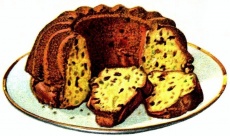
Ze zbiorku przepisów na ciasta wydanego po polsku w latach 1930. przez zakłady Dr. Oetkera w Oliwie (Wolne Miasto Gdańsk)
| Baba jest potrawą polską wynalezioną przez Stanisława Leczinskiego [sic], króla polskiego i wielkiego [sic] księcia Lotaryngii i Baru, władcę, który był wielkim smakoszem u schyłku swoich dni, a któremu nie była wcale obcą praktyka kuchenna. Szafran i rodzynki korynckie są głównymi przyprawami baby, jednakże niewielu kucharzy potrafi dobrze ją wykonać. | ||||
— Alexandre-Balthazar-Laurent Grimod de La Reynière: Manuel des amphytrions, Paris: Capelle et Renard, 1808, p. 170, tłum. własne
Original text:
|
Zresztą w przedrewolucyjnej Francji rum był rzadkością, głównie ze względu na zaporowe cła, którymi państwo chroniło producentów rodzimych koniaków i innych alkoholi. Dopiero na początku XIX w. nad Sekwanę zawitała z Anglii moda na poncz, którego składnikiem był sprowadzany z Karaibów rum z trzciny cukrowej. W latach 40. tegoż stulecia rum zaczął pojawiać się we francuskich przepisach na desery. I tak smakowita legenda o polskim królu, który macza suchy kuglof w rumie i nazywa go imieniem baśniowego bohatera, rozsypuje się jak domek z kart. Najlepiej podsumował to historyk jedzenia, pan Michael Krondl:
| Francuzi uwielbiają opowiadać anegdoty o swoim jedzeniu, a jeśli jeszcze uda się skojarzyć potrawę z jakąś znaną postacią, to tym lepiej. Niektóre z tych opowieści są prawdziwe, wiele jest zmyślonych, a bywają i takie, co jak napoleonka czy kremówka składają się z warstw kruchego faktu i puszystej fikcji. Nie da się ich ładnie rozdzielić, a nawet gdyby udało się zeskrobać całe wypełnienie, to pozostała prawda może okazać się nieco sucha. | ||||
— Michael Krondl: Sweet Invention: A History of Dessert, Chicago Review Press, 2011, p. 171, tłum. własne
Original text:
|
Zanurzanie pojedynczych kawałków suchego ciasta w winie, kawie czy czekoladzie było niewątpliwie starą praktyką, ale to nie to samo co nasączanie całej baby przed podaniem. Kto zatem wpadł na taki pomysł? Tego nie wiemy, ale wiadomo na przykład, że w 1845 r. Auguste Julien, współwłaściciel ciastkarni przy placu de la Bourse w Paryżu, włączył do swojej oferty babeczki z kawałkami kandyzowanej skórki pomarańczy zamiast rodzynek i nasączane syropem na bazie rumu (albo kirschu). A że, jak już wiemy, Francuzi wolą te potrawy, które kojarzą im się z celebrytami, to nazwał tę babkę savarin (wym. sawa-rę)[10] – od nazwiska słynnego smakosza, który nazywał się Jean-Anthelme Brillat (1755–1826; wym. żanan-telm bri-ja), ale zmienił nazwisko na Savarin, żeby dostać spadek po ciotce.[11]
Jeśli chodzi o charakterystyczny kształt baby czy gugelhupfa, który gdzieniegdzie nazywano też „głową Turka”, to podobne formy stosowali już starożytni Rzymianie ok. 200 r.n.e.[12] Z czego wynika, że historia zatoczyła koło – z dawnego Rzymu, przez Niemcy, Polskę, Alzację, Francję, z powrotem do Włoch i neapolitańskich babà al rum.
Przepis
Historia zatoczyła też koło, gdy do Polski trafiły przepisy na niby polskie baby, ale nasączane alkoholizowanym syropem. Oto jeden z nich, na babki z ponczem na bazie araku (w tej wersji poncz dolewa się do ciasta przed upieczeniem):
| Ordinary punch: Soak one pound of sugar in water, but first use it to scrape the zest of six lemons, put it immediately into a pot and boil into syrup; pour a quart of arak and then the juice squeezed from the six lemons into the syrup; keep some time under cover, then pour the essence into a bottle […]
Punch babas: Mix two pounds of fine flour with a quart of lukewarm milk and 4 tablespoons of thick yeast, add 10 whole eggs and a quarter of a pound of sugar; leave in a warm place for the night; in the morning, add a pound of lukewarm pre-melted butter and half a quart of punch essence. Knead the dough thoroughly, baste small moulds with fresh butter, half-fill them with the dough; after the dough has risen, put them into a medium-heated oven for the three quarters. Remove from moulds while hot. | ||||
— Bronisława L[eśniew]ska: Kucharz polski jaki być powinien: książka podręczna dla ekonomiczno-troskliwych gospodyń, Warszawa: S.H. Merzbach, 1856, p. 368, 424, own translation
Original text:
|
References
- ↑ René Goscinny, Albert Uderzo: Astérix : Le Combat des chefs, Paris: Hachette, 2013, p. 3
- ↑ Voltaire: Candide, or Optimism, trans. Robert M. Adams, ed. Nicholas Cronk, W.W. Norton & Company, 2016
- ↑ Baba, in: Wielki Słownik Języka Polskiego, ed. Piotr Żmigrodzki, Instytut Języka Polskiego PAN
- ↑ Maja Łozińska, Jan Łoziński: Historia polskiego smaku: Kuchnia, stół, obyczaje, Warszawa: Wydawnictwo Naukowe PWN, 2012, p. 173–174
- ↑ Baba, in: Elektroniczny słownik języka polskiego XVII i XVIII wieku, ed. Włodzimierz Gruszczyński, Warszawa: Instytut Języka Polskiego PAN
- ↑ Michael Krondl: Sweet Invention: A History of Dessert, Chicago Review Press, 2011, p. 173
- ↑ Kugelhopf, in: Annie Perrier-Robert: Dictionnaire de la gourmandise, Paris: Robert Laffont, 2012
- ↑ Elizabeth Field: Stohrer, Nicolas, in: Darra Goldstein: The Oxford Companion to Sugar and Sweets, Oxford University Press, 2015, p. 657
- ↑ M. Krondl, op. cit., s. 171
- ↑ M. Krondl, op. cit., s. 172
- ↑ Larousse Gastronomique, ed. Joël Robuchon, 1997, p. 141
- ↑ Melitta Weiss Adamson: Food in Medieval Times, Greenwood Press, 2004, p. 69
| ◀️ Previous | 📜 List of posts | Next ▶️ |
| ⏮️ First | 🎲 Random post | Latest ⏭️ |
